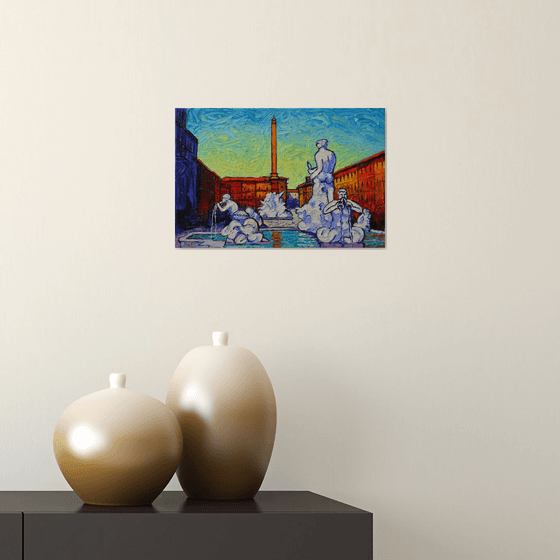Main Navigation
Original artwork description:
ORIGINAL MODERN IMPRESSIONIST TEXTURAL IMPASTO PALETTE KNIFE OIL PAINTING ON STRETCHED CANVAS, 30 X 20 CM ( DEPTH - 2 CM )
Inspired by my travel to Rome, Italy, this painting presents a beautiful view of Piazza Navona with Fontana del Moro ( Moor Fountain ) in the foreground. While my husband and I were there we stayed at a very nice hotel exactly near Piazza Navona . All the mornings we had our coffees at the wonderful terraces in Piazza Navona and I made some sketches there.
I realized this modern textural impressionist oil painting in impasto technique by applying thick layers of oil paints with different types of palette knives. In this way I am able to create various palette knife strokes and textures that, by interacting one with each other, give a semi abstract feeling to my paintings.
Fontana del Moro (Moor Fountain) is a fountain located at the southern end of the Piazza Navona in Rome, Italy. It represents a Moor, or African (perhaps originally meant to be Neptune), standing in a conch shell, wrestling with a dolphin, surrounded by four Tritons. It is placed in a basin of rose-colored marble.
The fountain was originally designed by Giacomo della Porta in 1575 with the dolphin and four Tritons. In 1653, the statue of the Moor, by Gian Lorenzo Bernini, was added. In 1874, during a restoration of the fountain, the original statues were moved to the Galleria Borghese and replaced with copies.
Piazza Navona is a square in Rome, Italy. It is built on the site of the Stadium of Domitian, built in the 1st century AD, and follows the form of the open space of the stadium. The ancient Romans went there to watch the agones ("games"), and hence it was known as "Circus Agonalis" ("competition arena"). It is believed that over time the name changed to in avone to navone and eventually to navona.
Defined as a public space in the last years of 15th century, when the city market was transferred there from the Campidoglio, Piazza Navona was transformed into a highly significant example of Baroque Roman architecture and art during the pontificate of Innocent X, who reigned from 1644 until 1655, and whose family palace, the Palazzo Pamphili, faced the piazza. It features important sculptural and creations: in the center stands the famous Fontana dei Quattro Fiumi or Fountain of the Four Rivers (1651) by Gian Lorenzo Bernini, topped by the Obelisk of Domitian, brought in pieces from the Circus of Maxentius; the church of Sant'Agnese in Agone by Francesco Borromini, Girolamo Rainaldi, Carlo Rainaldi and others; and the aforementioned Pamphili palace, also by Girolamo Rainaldi, that accommodates the long gallery designed by Borromini and frescoed by Pietro da Cortona.
Piazza Navona Flooded by Antonio Joli. Circa 1760
Piazza Navona has two other fountains. At the southern end is the Fontana del Moro with a basin and four Tritons sculpted by Giacomo della Porta (1575) to which, in 1673, Bernini added a statue of a Moor, wrestling with a dolphin. At the northern end is the Fountain of Neptune (1574) also created by Giacomo della Porta; the statue of Neptune, by Antonio Della Bitta, was added in 1878 to create a balance with La Fontana del Moro.
During its history, the piazza has hosted theatrical events and other ephemeral activities. From 1652 until 1866, when the festival was suppressed, it was flooded on every Saturday and Sunday in August in elaborate celebrations of the Pamphilj family. The pavement level was raised in the 19th century, and in 1869 the market was moved to the nearby Campo de' Fiori. A Christmas market is held in the piazza square.
PIAZZA NAVONA ROME ITALY is a modern impressionist textural impasto palette knife oil painting by Ana Maria Edulescu.
Materials used:
oil paints, canvas, palette knives
Tags:
#italy colors #ana edulescu #edulescu palette knife oil painting #neptune fountain #neptune's horses #italy beach #edulescu art #textural impressionism #stylized cityscape #stylized city #textural impressionist #stylized cities #edulesca #moor fountain #fontana del moro #rome old town #abstract #landscape #abstract art #abstract painting #colorful #contemporary #red #modern #green #contemporary art #impressionism #texture #colourful #sunset #abstraction #impressionist #cityscape #abstracts #sculpture #city #architecture #impressionistic #palette knife #impasto #sunrise #city scene #italy #textures #landscapes #impasto painting #rocks #architectural #travel #sunrise painting #abstract cityscape #italian art #palette knife painting #cityscapes #italian landscape #textural oil paint #panorama #european artist #old town #old #italian #old city #italian village life #panoramic landscapes #rome #aerial #panoramic #italy landscape #impasto thick texture #iconic #travel art #textural #italy cityscape #italy painting #stylized #modern impressionism #landmark #travelling #european landscape #picturesque #textural abstract art #abstract city #impasto landscape #rome italy #textural painting #italian seascape #moors #amalfi coast #colorful houses #colourful houses #aerial landscape #landmarks #textured oil painting #traveller #liguria italy #abstract architecture #italian village #rocks abstract modern #edulescu #rome art #aerial perspective #sculptures #textural abstract #neptune #fontana #abstract cities #moor #cinque terre art #rome scene #piazza #modern impasto painting #ana maria edulescu #italian island #stylized painting #rome sunrise #piazza navona #impressionist palette knife oil painting #rome sunset #fontana di trevi #navonaPIAZZA NAVONA MOOR FOUNTAIN ROME ITALY modern impressionism textural impasto palette knife oil painting stylized city scene by Ana Maria Edulescu (2018) Oil painting
by ANA MARIA EDULESCU
56 Artist Reviews
£324.27 Sold
- Oil painting on Canvas
- One of a kind artwork
- Size: 30 x 20 x 2cm (unframed) / 30 x 20cm (actual image size)
- Ready to hang
- Signed on the front
- Style: Impressionistic
- Subject: Architecture and cityscapes
Do you like this artwork?
This artwork has sold, but the artist is accepting commission requests. Commissioning an artwork is easy and you get a perfectly personalised piece.
Loading
Original artwork description
ORIGINAL MODERN IMPRESSIONIST TEXTURAL IMPASTO PALETTE KNIFE OIL PAINTING ON STRETCHED CANVAS, 30 X 20 CM ( DEPTH - 2 CM )
Inspired by my travel to Rome, Italy, this painting presents a beautiful view of Piazza Navona with Fontana del Moro ( Moor Fountain ) in the foreground. While my husband and I were there we stayed at a very nice hotel exactly near Piazza Navona . All the mornings we had our coffees at the wonderful terraces in Piazza Navona and I made some sketches there.
I realized this modern textural impressionist oil painting in impasto technique by applying thick layers of oil paints with different types of palette knives. In this way I am able to create various palette knife strokes and textures that, by interacting one with each other, give a semi abstract feeling to my paintings.
Fontana del Moro (Moor Fountain) is a fountain located at the southern end of the Piazza Navona in Rome, Italy. It represents a Moor, or African (perhaps originally meant to be Neptune), standing in a conch shell, wrestling with a dolphin, surrounded by four Tritons. It is placed in a basin of rose-colored marble.
The fountain was originally designed by Giacomo della Porta in 1575 with the dolphin and four Tritons. In 1653, the statue of the Moor, by Gian Lorenzo Bernini, was added. In 1874, during a restoration of the fountain, the original statues were moved to the Galleria Borghese and replaced with copies.
Piazza Navona is a square in Rome, Italy. It is built on the site of the Stadium of Domitian, built in the 1st century AD, and follows the form of the open space of the stadium. The ancient Romans went there to watch the agones ("games"), and hence it was known as "Circus Agonalis" ("competition arena"). It is believed that over time the name changed to in avone to navone and eventually to navona.
Defined as a public space in the last years of 15th century, when the city market was transferred there from the Campidoglio, Piazza Navona was transformed into a highly significant example of Baroque Roman architecture and art during the pontificate of Innocent X, who reigned from 1644 until 1655, and whose family palace, the Palazzo Pamphili, faced the piazza. It features important sculptural and creations: in the center stands the famous Fontana dei Quattro Fiumi or Fountain of the Four Rivers (1651) by Gian Lorenzo Bernini, topped by the Obelisk of Domitian, brought in pieces from the Circus of Maxentius; the church of Sant'Agnese in Agone by Francesco Borromini, Girolamo Rainaldi, Carlo Rainaldi and others; and the aforementioned Pamphili palace, also by Girolamo Rainaldi, that accommodates the long gallery designed by Borromini and frescoed by Pietro da Cortona.
Piazza Navona Flooded by Antonio Joli. Circa 1760
Piazza Navona has two other fountains. At the southern end is the Fontana del Moro with a basin and four Tritons sculpted by Giacomo della Porta (1575) to which, in 1673, Bernini added a statue of a Moor, wrestling with a dolphin. At the northern end is the Fountain of Neptune (1574) also created by Giacomo della Porta; the statue of Neptune, by Antonio Della Bitta, was added in 1878 to create a balance with La Fontana del Moro.
During its history, the piazza has hosted theatrical events and other ephemeral activities. From 1652 until 1866, when the festival was suppressed, it was flooded on every Saturday and Sunday in August in elaborate celebrations of the Pamphilj family. The pavement level was raised in the 19th century, and in 1869 the market was moved to the nearby Campo de' Fiori. A Christmas market is held in the piazza square.
PIAZZA NAVONA ROME ITALY is a modern impressionist textural impasto palette knife oil painting by Ana Maria Edulescu.
Materials used:
oil paints, canvas, palette knives
Tags:
#italy colors #ana edulescu #edulescu palette knife oil painting #neptune fountain #neptune's horses #italy beach #edulescu art #textural impressionism #stylized cityscape #stylized city #textural impressionist #stylized cities #edulesca #moor fountain #fontana del moro #rome old town #abstract #landscape #abstract art #abstract painting #colorful #contemporary #red #modern #green #contemporary art #impressionism #texture #colourful #sunset #abstraction #impressionist #cityscape #abstracts #sculpture #city #architecture #impressionistic #palette knife #impasto #sunrise #city scene #italy #textures #landscapes #impasto painting #rocks #architectural #travel #sunrise painting #abstract cityscape #italian art #palette knife painting #cityscapes #italian landscape #textural oil paint #panorama #european artist #old town #old #italian #old city #italian village life #panoramic landscapes #rome #aerial #panoramic #italy landscape #impasto thick texture #iconic #travel art #textural #italy cityscape #italy painting #stylized #modern impressionism #landmark #travelling #european landscape #picturesque #textural abstract art #abstract city #impasto landscape #rome italy #textural painting #italian seascape #moors #amalfi coast #colorful houses #colourful houses #aerial landscape #landmarks #textured oil painting #traveller #liguria italy #abstract architecture #italian village #rocks abstract modern #edulescu #rome art #aerial perspective #sculptures #textural abstract #neptune #fontana #abstract cities #moor #cinque terre art #rome scene #piazza #modern impasto painting #ana maria edulescu #italian island #stylized painting #rome sunrise #piazza navona #impressionist palette knife oil painting #rome sunset #fontana di trevi #navona14 day money back guaranteeLearn more









